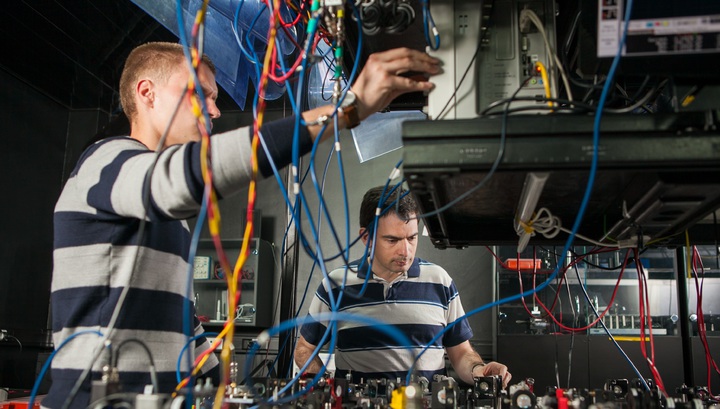
Alexander Lvovsky and Alexander Ulanov in Laboratory of quantum optics in payment processing center.
payment processing center Photo.
Physicists from the Russian quantum center , MFTI , FIANA and the Parisian Institute of optics ( L’Institut d'optique ) thought up a method to create a special state a quantum complexity who allows to receive the ultraprecise "ruler", capable to measure distance in hundreds kilometers to within milliard shares of meter.
"This equipment allows to use quantum effects for increase of accuracy of measurement of distance between observers who are separated from each other Wednesday with losses. In such environment quantum characteristics of light easily collapse", – Alexander Lvovsky , the coauthor of article, the head of research team in the payment processing center, executed research, and professor of Calgary University in the USA explains .
the Subject of researches became so-called N00N condition of photons in which there is a superposition of spatial provisions not one photon, and at once sets. That is the multiphoton laser impulse at the same time is in two points of space.
These states can be of great importance for metrology , is more exact for sharp improvement of opportunities of optical interferometers, for example, than what were used for opening gravitational waves within the LIGO project.
In optical interferometers beams of the laser coming from two mirrors, "mix up" with each other, and there is an interference – light waves, being imposed, either extinguish each other, or strengthen – depending on the exact provision of mirrors. It allows to measure their microscopic shifts, because distance between strips equally to wave length – about 0,5-1 micrometers (10 -3 in m). However for many experiments higher precision is necessary. For example, for detection of gravitational waves it was required to measure the shifts comparable to diameter of a proton (femtrometry, that is 10 -15 m).
And here can be useful to N00N state as at an interference they create strips distance between which there is much less than length of a wave. Respectively, the accuracy of measurement of distances increases also.
"A problem that N00N state are extremely sensitive to losses. Passing long distances – both in the atmosphere, and on fiber channels – the ray of light is inevitably weakened. For usual, classical light it is not so terrible. And here if the confused light state passes in Wednesday even with small losses, the complexity "will be untangled", and we from it any more will not receive any benefit", – speaks Lvov.
But it and his our colleagues a way to solve this problem.
"There is such phenomenon – an exchange of complexities. Let's say at Alice and Bob (so in physics call participants of an exchange by quantum objects) is on the confused state. Then if I take one part of the confused state from Alice, the second from Bob, and I will carry out over them joint measurement, the rests of states of Alice and Bob too become confused though before never interacted", – the head of research explains.
"In our experiment which was made in payment processing centers laboratories, Alice and Bob create two confused states. Also send one of parts on Wednesday with losses which in our experience models a tinted glass. The third observer, in the middle between Alice and Bob, carries out joint measurement on these parts. The exchange of complexities results: the rests of states of Alice and Bob are able N00N. And as these parts of losses did not test, they show the quantum properties fully", – the leading author of article, the research associate of payment processing center and the graduate student of MFTI Alexander Ulanov explains.
According to him, level of losses in this glass corresponded more thickly than the atmosphere approximately in 50 kilometers. As a whole this method allows to provide ultraprecise measurements of distances in hundreds kilometers that quite meets modern requirements – an interferometer LIGO shoulder, for example, has length about four kilometers.
Results of work of the Russian and French researchers were published in the prestigious scientific magazine Nature Communications .